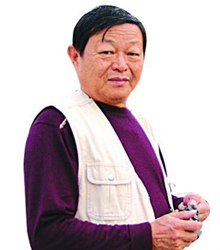| Heroic Captain
 |
|
(FILE) |
Fan Shuren, the captain of a Panama-registered Chinese cargo ship from Nantong, east China's Jiangsu Province, was shot dead by pirates in waters near Nigeria on February 14. That day, the ship encountered pirates near the port of Lagos, Nigeria. In an effort to cover the retreat of other crew members, Fan remained on the navigation bridge and was shot dead along with the chief engineer who was from Taiwan.
Fan, 64, became a captain in 1990. The captain reached his retirement age four years ago, but he stayed with his job in order to support his family.
Pritzker Prize Winner
 |
|
(IC) |
Wang Shu, an architect in Hangzhou, east China's Zhejiang Province, received this year's Pritzker Architecture Prize on February 27, becoming the first Chinese to win the prestigious prize. The prize, founded in Chicago in 1979 by the Pritzker family, owner of the Hyatt Hotel Group, is often likened to architecture's Nobel Prize.
"The fact that an architect from China has been selected by the jury represents a significant step in acknowledging the role that China will play in the development of architectural ideals," said Thomas J. Pritzker, head of the Hyatt Foundation, in announcing the prize.
"This is really a big surprise," said 48-year-old Wang. "I suddenly realized that I've done many things over the last decade. It proves that earnest hard work and persistence lead to positive outcomes."
Wang's work includes the Wenzheng College library at Suzhou University in east China's Jiangsu Province, which was completed in 2000 and won him the Architecture Arts Award of China in 2004. The work embodies his architectural philosophy— paying close attention to environment. It is also a reflection of the architectural idea of Chinese classical gardens.
Wang and his wife founded the Amateur Architecture Studio in Hangzhou in 1997. He now heads the Architecture Department of the China Academy of Art in Hangzhou and has taught or lectured at Harvard, UCLA, the University of Pennsylvania and the University of Texas.
All-inclusive Services
The Chinese Government has pledged to provide equal access to public services for people living in urban areas without proper residential permits.
Future policies and measures on essential public services, including employment assistance, compulsory education and occupational training, will not be based on whether a resident has a permanent residential permit or not, according to a national guideline on reforming the country's household registration system.
The guideline, dated February 26, 2011, was posted on the official website of the Chinese Government on February 23.
Under China's household registration system, many urban public services are still only available to registered urban residents within certain administrative regions. The system was introduced in the 1950s to reduce mobility and maintain social order under a planned economy.
Recent statistics show that the number of migrant workers reached 252.78 million in 2011, with 158.63 million of them leaving the towns they are registered to live in to seek employment elsewhere, usually in urban areas.
The guideline proposes creating a unified household registration system, as well as granting equal access to public services for both urban and rural residents.
Post-quake Reconstruction
The reconstruction of parts of southwest China's Sichuan Province, which was hit by a devastating earthquake in May 2008, has been completed, said Vice Governor Wei Hong on February 24.
Wei said that 99.5 percent of the budget, or 865.8 billion yuan ($137.5 billion), has been invested in post-quake reconstruction efforts, and 99 percent of 29,692 related projects have been completed.
Local governments have helped more than 12 million people in rural and urban areas repair their houses, and have relocated 200,000 farmers who lost their farmland.
According to official statistics, in 2011, the total output value of the six hardest-hit cities and prefectures was almost double that of the pre-quake period, with urban per-capita disposable income growing by 1.7 times and farmers' net income by 1.75 times.
The 2008 quake hit Sichuan and neighboring Gansu and Shaanxi provinces, leaving more than 80,000 people dead or missing and millions of homes destroyed.
Land Rehabilitation
China has announced a target of rehabilitating 250,000 square km of eroded land to make it habitable again by 2015.
Speaking at a national meeting on water loss and soil erosion in Nanning, south China's Guangxi Zhuang Autonomous Region, on February 25, Chen Lei, Minister of Water Resources, said that the country also aims to build 2.67 million hectares of agricultural terraces in the same period to ensure food supplies for 30 million people.
China has already rehabilitated 1.1 million square km of land, benefiting 150 million residents over the past 10 years.
Nearly one third of China's land is vulnerable to soil erosion, and the situation is particularly bad in the country's western regions.
Polar Research
China has launched a special project to research and evaluate environmental issues in polar regions.
The project, starting on February 24, will include five Antarctic expeditions and three Arctic missions over the next five years, according to a press release from the State Oceanic Administration.
Researchers will focus on polar environments, climate change and disputes between different countries regarding polar interests, the administration said in a press release.
In 2011, Chinese scientists completed 61 research projects at three Antarctic research stations and one Arctic station.
International Students
A record 292,611 students from 194 countries and regions studied in China in 2011, up 10.38 percent from the previous year, figures from the Ministry of Education show.
These students studied in 660 colleges, academic institutions and other educational organizations.
Of the total, 25,687 were supported by scholarships from the Chinese Government, up 14.73 percent year on year. Self-funded students, who accounted for the rest, a yearon- year increase of 9.98 percent.
The Republic of Korea is the largest source of international students for China, followed by the United States and Japan.
According to the ministry, China aims to attract 500,000 overseas students by 2020.
Food Safety Action
China's food and drug safety watchdog opened a national center on February 27 to receive complaints on pharmaceuticals, health food products, cosmetics and catering.
A subsidiary of the State Food and Drug Administration, the center handles reports of wrongdoing during research, development, production, distribution and utilization.
It is also responsible for coordinating efforts to inspect the relevant enterprises and individuals, compiling analysis reports and publicizing investigation reports, the administration said.
China has seen recurring drug and food safety scandals in recent years and the government over the months has introduced a series of measures to boost food and drug safety. | 